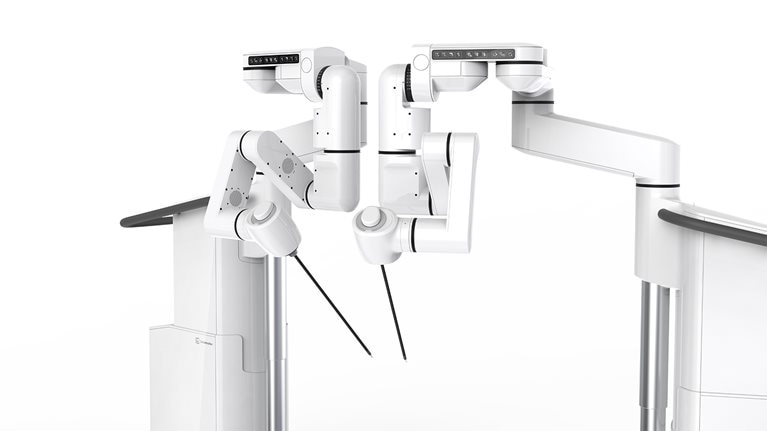When German internist and surgeon Georg Kelling performed the first laparoscopic surgery in 1901, he likely hadn’t envisioned that machines would one day follow in his footsteps. But today, robotic surgery is a health-care reality that promises certain benefits, like improved surgical precision that can contribute to quicker patient healing times.
Still, widespread adoption of the technology has remained elusive. “The traditional approach to robotic surgery brings with it a lot of complexity and high cost,” says Marcus Heneen, a design director at McKinsey Design.
Today’s surgical robots, Marcus explains, tend to situate the surgeon at a console in a non-sterile environment away from the patient. This is not ideal. Communication between surgeons and their operating-room teams can be difficult, and urgent manual interventions can be slow.
Armed with a vision to address these challenges, the Swiss medical-device startup Distalmotion created its own surgical robot: Dexter. The winner of a 2020 iF World Design Guide award, Dexter is a new system that can be easily draped and operated in a sterile environment, allowing surgeons and their operating teams to quickly toggle between robotic and manual modes as needed.

Change that Matters
After several years of working on the concept for Dexter, Distalmotion reached out to our McKinsey Design colleagues to help bring the concept to life in a way that would optimize the user experience.
“We began by taking a close look at the surgeon’s main interaction point with Dexter: the hand grips,” says Marcus. “We approached the design challenge holistically, aiming to create an interface that caters to control, precision, and comfort.”
To test and understand how Dexter might best support the people who would use it, surgeons and nurses were regularly brought in to inform design decisions. “You really can’t design something without being fully immersed in the users’ reality and experiences,” adds Thomas Nilsson, a McKinsey Design expert partner.

They gave feedback on aspects like draping procedures, endoscope control, and the setup of imaging systems. “We asked several questions,” says Thomas, “like, how should the whole robotic system be configured to fit with common practices in the operating room? What should the behavior and tactile feedback be like in the grips? What size should they be to accommodate for different physical and habitual attributes?”
The effectiveness of this approach is backed up by our research, which shows that for certain medtech companies, patient-centric and clinician-centric design are critical ways to stand out from competitors and unlock positive impacts on market share, access, and reimbursement.
“We know from experience that human-robot interaction works best when technology caters to the social setting in which it is deployed,” says Marcus. “Surgery is not a purely mechanical task of making incisions and joining tissue. It’s a collaborative process between surgeons and their teams with a strong social component to it.”
Seamlessly integrating robotic and laparoscopic processes also lowers the barriers to mastering robot-assisted surgery. Historically, learning robotic surgery has meant needing to be well-versed in all aspects of robotics. When the switch between robotics and manual laparoscopy is quick and easy, the threshold for feeling comfortable is much lower, making the adoption of the robotic system faster
With just two arms that control the robot’s instruments, Dexter is significantly less complex and leaner in size than traditional robots. It offers ample space for the assistant surgeon and optimal ergonomic posture for the surgeon to operate in a seated or standing position, unlike manual laparoscopic surgery that often entails standing for hours.
“It’s a real paradigm shift in robotic surgery, where we finally have something that’s not a one-size-fits-all model,” says Thomas.
You really can’t design something without being fully immersed in the users’ reality and experiences.
Michael Friedrich, CEO of Distalmotion, points to still another benefit of Dexter. “In addition to the cost reductions that come with reduced complexity,” he says, “Dexter will widen the repertoire of operations that can be performed with robotic aid. This means more surgeons will have access to robotic surgery and more patients stand to reap its benefits.”
Over the last 18 months, McKinsey Design and Distalmotion have worked closely together to bring this vision to life. After daily iterations and hundreds of prototypes of grips, triggers, armrests, robotic arms, mechanical joints, interaction surfaces, cable routing, and drapes, Dexter is here.
“We have tested, challenged, and scrutinized every single design aspect of the system,” says Marcus. “All of this is to transform the operating room for both surgeons and patients alike.”